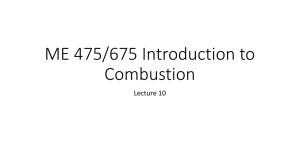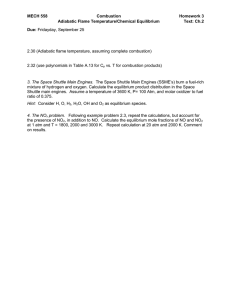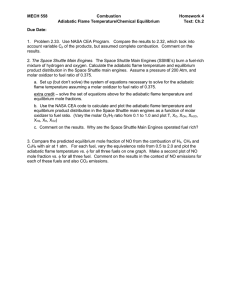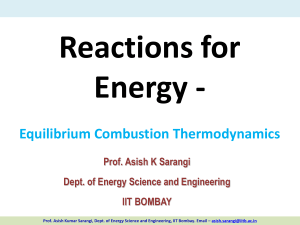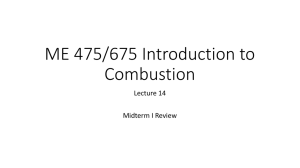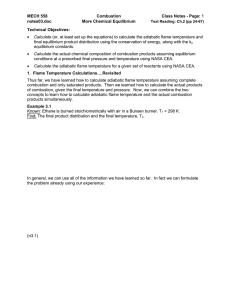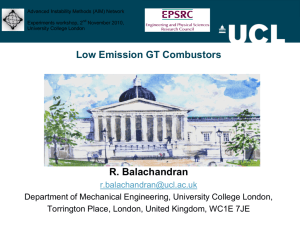Slides
advertisement
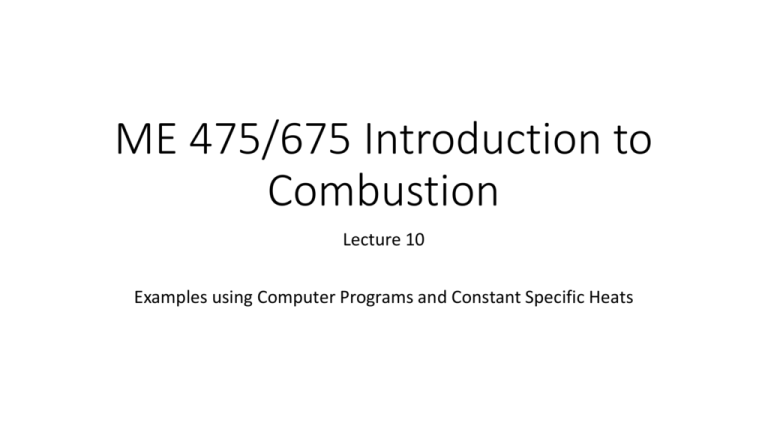
ME 475/675 Introduction to Combustion Lecture 10 Examples using Computer Programs and Constant Specific Heats Announcements • FALL 2015 CAREER FAIR • • • • Today! Wednesday, September 16 Now: 10:00 am to 3:00 pm Grand Ballroom at the Joe Crowley Student Union Learn more about career services • Midterm 1 • September 28, 2015 • HW 4 • Due Friday, September 18, 2015 (I’ll accept it Monday 9/21/15) • Ch 2 (33, 47, 57, 50, 54, 63) Problem 2.47 (homework) 1 𝑂 2 2 • Calculate the equilibrium composition for the reaction 𝐻2 + ↔ 𝐻2 𝑂 when the ratio of the number of moles of elemental hydrogen to elemental oxygen is unity. The temperature is 2000 K, and the pressure is 1 atm. • Extra: What will happen to the amount of 𝐻2 if the pressure is decreased? • At what pressure will 𝜒𝐻2 = 0.01? Problem 2.50 (homework) • Reformulate problem 2.47 to include the species OH, O, and H. Identify the number of equations and the number of unknowns. They should of course be equal. (Write a system of equations that can be used to solve for the unknowns). Do not solve your system. Problem 2.54 (Homework) • Consider the combustion of decane (C10H22) with air at an equivalence ratio of 1.25, pressure of 1 atm, and temperature of 2200 K. Estimate the mixture composition assuming no dissociation except for the water-gas shift equilibrium. Compare with results of TPEQUIL. • Hint: MathCAD Solution Problem 2.63 (Homework) • A furnace uses preheated air to improve its fuel efficiency. Determine the adiabatic flame temperature when the furnace is operating at a mass air-fuel ratio of 16 for air preheated to 600 K. The fuel enters at 200 K. • Assume the following simplified thermodynamic properties: Tref = 300 K, MWfuel 𝑜 = MWair = MWprod = 29 kg/kmol; cp,air = cp,prod = cp,fuel = 1200 J/kg-K; ℎ𝑓,𝑎𝑖𝑟 = 𝑜 𝑜 ℎ𝑓,𝑝𝑟𝑜𝑑 = 0; ℎ𝑓,𝑓𝑢𝑒𝑙 = 4 ∗ 107 𝐽/𝑘𝑔 Problem 2.33 (Homework) • Once more, repeat problem 2.30, but eliminate the unrealistic assumptions, i.e. allow for dissociation of the products and variable specific heats. Use HPFLAME (Appendix F), or other appropriate software. Compare and contrast the results of problems 2.30 to 2.33. Explain why they differ. • 2.30 Determine the adiabatic flame temperature for constantpressure combustion of a stoichiometric propane-air mixture assuming reactant at 298K, no dissociation of the products, and constant specific heats evaluated at 298K. • www.mhhe.com/turns3e Problem 2.35 (homework) • Repeat problem 2.30, but for constant-volume combustion. Also, determine the final pressures. • Add, compare results with UVFLAME Computer Programs Provided by Book Publisher • Described in Appendix F • For “complex” reactions (11 product species) • Fuel: CNHMOLNK • Oxidizer: Air • Download from web: www.mhhe.com/turns3e • • • • student edition Computer codes Access to TPEquil, HFFlame, UVFlame Extract All • TPEQUIL (TP Equilibrium) • Use to find • Equilibrium composition and mixture properties • Required input • • • • Fuel CNHMOLNK Temperature Pressure Equivalence ratio (with air) • to determine initial number of moles of each atom HPFLAME (HP Flame) • Use to find • Adiabatic flame temperature for constant pressure • Required Input • Fuel, equivalence ratio, enthalpy of reactants HR, pressure • For constant pressure: HP = HR • Find TAd • In our examples we assume ideal combustion so we knew the product composition • But this program calculates the more realistic equilibrium composition of the products from a (complex) equilibrium calculation (multiple equilibrium reactions) • But this requires TProd = TAd, which we are trying to find! • Requires program (not humans) to iterate
